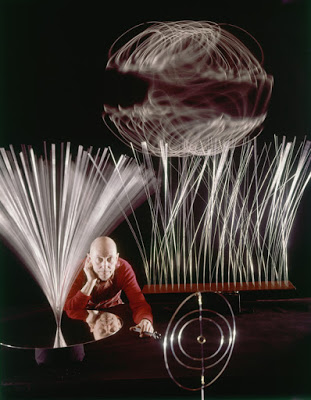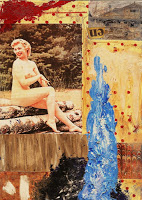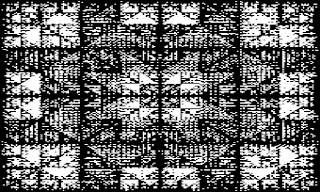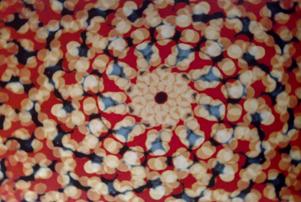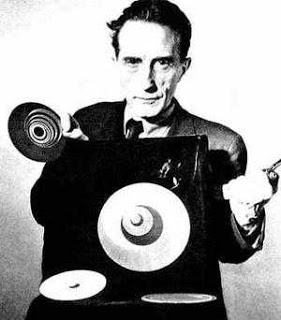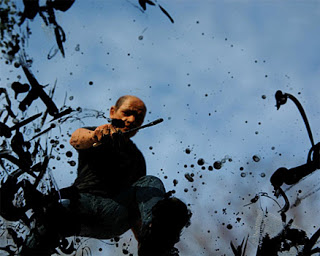Oddball Films presents Strange Sinema 95, a monthly screening of new finds, old gems and offbeat oddities from Oddball Films’ vast collection of 16mm film prints. Drawing on his collection of over 50,000 16mm film prints, Oddball Films director Stephen Parr has compiled his 95th program of classic, strange, offbeat and unusual films. This installment, Strange Sinema 95: Experiments in Art and Cinema is a heady, techno-cultural look at the multimedia art forms and cinematic uprisings of the tumultuous 60s and 70s featuring a vast array of evolutionary artists, cultural criticism and eye-popping movement art. Art of the Sixties (1967), features the monumental soft sculptures of pop icon Claes Oldenburg, machine artist and animator Len Lye, Les Levine’s interactive environments, action painter provocateur Jackson Pollock and more. A seldom seen NET documentary USA Artists: Robert Rauschenberg (1966) showcases a young Rauschenberg’s innovative “Revolvers” or “Combines”- multilayered painted sculptures that expand the boundaries of art. Merce Cunningham (1964) the extremely rare French-made poetic montage of movement pioneer Merce Cunningham’s dance performances in collaboration with life partner and composer John Cage with “found object” sets by Robert Rauschenberg. Underground Film (1970), is another rare exploration into the work of seminal experimental filmmaker (and SF Cinematheque foundress) Chick Strand, a pioneer in blending avant-garde techniques with documentary. The Critic (1963), an animated Oscar-winner from the great Ernie Pintoff -watch as comedy legend Mel Brooks relentlessly rags on the experimental animation he's shown to hilarious effect. Also screening will be an excerpt from USA Artists: Jim Dine (1966), a live performance from the sixties artist instrumental in creating early “Happenings” - live, non-linear multimedia events. The evening will also include a breathtaking selection of Whitney films, featuring motion graphics pioneer John Whitney Sr., brother James and son Michael's work, all profoundly audacious and inspiring in their fluidity, motion and spiritual subtext. John Whitney's Arabesque (1975) is a legendary masterpiece of shimmering, oscillating waves set to the music of Persian composer Maroocheher Sadeghi. Michael Whitney's Binary Bit Patterns (1969) is a hypnotic psych-folk audiovisual experience that suggests a secret symbiosis between the digital and the organic as various Eastern graphic permutations appear, dissolve and undergo metamorphoses on the screen. Lapis (1965), made by a spiritualized James Whitney (one of only 7 films he created) and one of the most accessible experimental films ever made; Lapis was created with handmade cels evoking a single mandala moving within itself; its particles surge around each other in constant metamorphosis. To foreground our program, and starting promptly at 8PM is the rare documentary Richter on Film (1972) profiling Dadaist and abstract/avant-garde filmmaker Hans Richter as he talks about his ground-breaking experimental films of the 1920s.
Date: Friday, December 11th, 2015 at 8:00PM
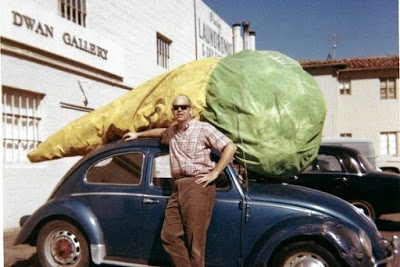
Venue: Oddball Films, 275 Capp Street, San Francisco
Admission: $10.00 Limited Seating, RSVP to: 415-558-8117 or RSVP@oddballfilm.com
Web: www.oddballfilms.blogspot.com
Featuring:
The Art of the Sixties (Color, 1967)
This rarely seen documentary aired on CBS at the height of the revolutionary and hopeful changes sweeping the art world (not to mention the rest of society). The film takes an inside look at some of the leading figures in art during the decade, including rare glimpses into their studios and working processes. Highlights include soft-sculpture pop iconographer Claes Oldenburg who states “My work is not meant to be funny or even art, my work is just made to be important”, Jackson “The Dripper” Pollock, conceptualist Sol Lewitt, Les Levine, and other artists who have since become emblematic of the wild experimentation of and use of industrial processes (Rauschenberg’s silkscreens, Barnett Newman’s steel fabricated sculptures) of the 60s. We also follow pioneering filmmaker, sculptor and oddball engineer Len Lye as he demonstrates his large-scale kinetic sound sculptures.
USA: Artists: Robert Rauschenberg (B+W, 1966)
A fascinating portrait of Robert Rauschenberg, one of the forerunners of Pop Art and one of the most influential artists of the 20th century. Rauschenberg’s legendary explorations into painting, mixed media, theater, performance art and costume design influenced generations of artists and together with Pop artists like Jasper Johns, collaborators like composer John Cage and dancer/choreographer Merce Cunningham stretched and redefined the boundaries of the American art. From his patricidal “Erased DeKooning”* work to his co-founding of (E.A.T.) Experiments in Art and Technology in 1966, (formed as a collaborative link between artists and engineers), to his pioneering “combine paintings” using revolving discs to his work incorporating found objects and photo silkscreened images, Rauschenberg’s work is legendary.
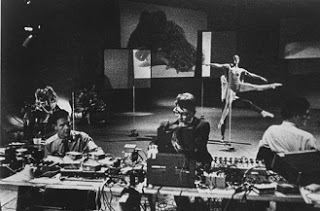
Merce Cunningham/ Image et technique/Merce Cunningham (B+W, 1964)
A very rare 16mm print, this French-made poetic montage features excerpts of movement pioneer Merce Cunningham’s dance performances shot at the Théâtre de l’Est Parisien and Comédie de Bourges in June 1964. Cunningham, a major figure in 20th century dance collaborates here with life partner and composer John Cage (who creates a wall of industrial sound) with “found” material sets by pop artist Robert Rauschenberg. The film features dancers Raynal, Jackie, Etienne Becker, and Patrice O’Wyers.
For more info on Cunningham and Cage’s influence read:
https://www.washingtonpost.com/entertainment/theater_dance/john-cage-with-merce-cunningham-revolutionized-music-too/2012/08/30/a3edbaf8-f177-11e1-892d-bc92fee603a7_story.html
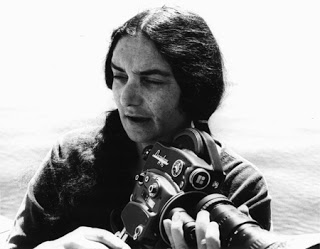
Underground Film (1970, Color)
An exploration into ‘underground’ film through the eyes (and films) of California experimental filmmaker, Chick Strand (1931-2009), this documentary gives a close look into the life and work of one of the west coast’s (and Bay Area’s) most innovative independent filmmakers. Included among the interviews and footage of Strand working is a full-length version of her film, Anselmo, shot in Mexico in 1967. Lush color, layered images and intimate cinematography create an inimitable portrait of a musician friend and a tuba in Anselmo. Working in 16mm and Super 8mm, Chick Strand was one of a group of Bay Area filmmakers including Bruce Baillie, Gunvor Nelson, Dorothy Wiley, and Robert Nelson (to name a few) who established Canyon Cinema, San Francisco Cinematheque, and self published a journal of writings from and on filmmakers working in the area in the ‘60s and ‘70s. These filmmakers’ film work and efforts established a unique Bay Area community of distribution and exhibition for local film artists and have had an indelible impact on West Coast experimental and independent film aesthetics.
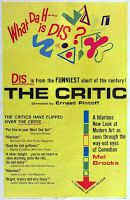
The Critic (Color, 1963)
An animated Oscar winner from the great Ernie Pintoff- the “Critic is Mel Brooks, sitting in a movie theater. Loudly describing/deriding what he sees on the screen (a spoof of a Norman McLaren-styled animation). Brooks' old man character relentlessly rags on the experimental animation he's shown to hilarious effect.
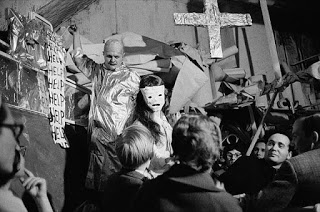
USA Artists: Jim Dine (excerpt, 1966, B+W)
From NET (National Educational Television) we feature an excerpt from one of artist Jim Dine’s “Happenings”, an early form of performance art. While critics tried to pigeonhole Dine as a “pop” artist he strongly insisted he was simply making art and not part of a school. “I don’t care anymore about the avant garde-it’s too easy to be a shocker”, said Dine. He created happenings like “Smiling Worker” (1959) and “Car Crash” (1960) and worked with John Cage, Alan Kaprow and leading neo-dada, surrealist and avant garde artists of his time. His experiments with exposing himself as a medium broke boundaries in the theater and pushed audiences to come forward toward his work instead of being catered too. “I trust thoroughly the meat of the unconscious” said Dine.
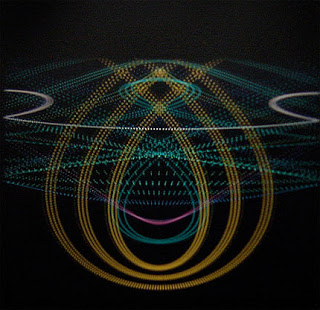
Arabesque (Color, 1975)
John Whitney‘s Arabesque, is considered by many to be the seminal computer film. Set to the music of Manoochelher Sadeghi, and created during a residency at IBM Whitney balanced science with aesthetics as he experimented with the eccentricities of Islamic architecture creating whirling, exotic flows of computer generated images. Arabesque was one of the first computer generated films that married technology and art is a focused, cinematic manner. Working with his early home-made computerized motion-control set-up, Whitney could produce a variety of innovative designs and metamorphoses of text and still images, which proved very successful in advertising and titling of commercial projects. He also did various commercial assignments including the title design for Hitchcock's feature Vertigo (in association with Saul Bass), and the preparation (in association with Charles Eames) of a seven-screen presentation for the Buckminster Fuller Dome in Moscow.
Binary Bit Patterns (Color, 1969)
The spectacular, fast-paced film features quilt-like tapestries of polyhedral and crystalline figures pulsating and multiplying with a kind of universal logic eliciting a hypnotic, trancelike effect from the viewer. This film echoes a preoccupation with the mandala image and the interest in Eastern meditative philosophy that is seen in the work of the whole Whitney family. Employing computer generated imagery with optically introduced color and flicker effects, Michael Whitney creates a hypnotic, psych-folk audiovisual experience that suggests a secret symbiosis between the digital and the organic as various Persian inflected graphic permutations appear, dissolve and undergo metamorphoses on the screen. With original sound-score.
Lapis (Color, 1965)
This film, by film pioneer James Whitney consists entirely of dot patterns. Like a
single mandala moving within itself, the particles surge around each other in constant metamorphosis, a serene ecstasy of what Jung calls "individuation." For 10 minutes, a succession of beautiful designs grows incredibly, ever more intricate and astounding; sometimes the black background itself becomes the pattern, when paths are shunned by the moving dots. A voluptuous raga soundtrack by Ravi Shankar perfectly matches the film's flow, and helped to make LAPIS one of the most accessible "experimental films" ever made.
The images were all created with handmade cels, and the rotation of more than one of these cels creates some of the movements. John Whitney Sr. had built a pioneer computerized animation set-up—the prototype for the motion-control systems that later made possible such special effects as the "Star Gate" sequence of 2001. James used that set-up to shoot some of his handmade artwork, since it could ensure accuracy of placement and incremental movement.
For more information about John, James and Michael Whitney’s work:
http://en.wikipedia.org/wiki/John_Whitney_(animator)
http://en.wikipedia.org/wiki/James_Whitney_(filmmaker)
Another link to James Whitney’s influences and life: http://www.centerforvisualmusic.org/WM_JWsight.pdf
Richter on Film (1972)
The brilliant painter, Dadaist and abstract/avant garde filmmaker Hans Richter talks about his experimental films of the 1920's. Excerpts from Rhythm 2 (1921), Race Symphony (1928), and Ghosts Before Breakfast (1927) are included. Richter moved from Switzerland to the United States in 1940 and taught in the Institute of Film Techniques at the City College of New York.
While living in New York, Richter directed two feature films, Dreams That Money Can Buy (1947) and 8 x 8: A Chess Sonata in 8 Movements (1957) in collaboration with Max Ernst, Jean Cocteau, Paul Bowles, Fernand Léger, Alexander Calder, Marcel Duchamp, and others. In 1957, he finished a film entitled Dadascope with original poems and prose spoken by their creators: Hans Arp, Marcel Duchamp, Raoul Hausmann, Richard Huelsenbeck, and Kurt Schwitters. Richter was also the author of a first-hand account of the Dada movement titled Dada: Art and Anti-Art which also included his reflections on the emerging Neo-Dada artworks.
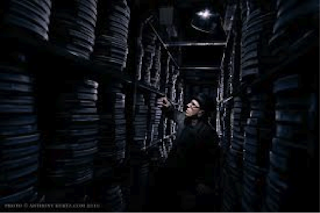
Curator Biography:
Stephen Parr’s programs have explored the erotic underbelly of sex-in-cinema (The Subject is Sex), the offbeat and bizarre (Oddities Beyond Belief), the pervasive effects of propaganda (Historical/Hysterical?) and oddities from his archives (Strange Sinema). He is the director of Oddball Films, a stock film company and the San Francisco Media Archive (www.sfm.org), a non-profit archive that preserves culturally significant films. He is a co-founder of Other Cinema DVD and a member of the Association of Moving Archivists (AMIA) where he is a frequent presenter.
About Oddball Films
Oddball films is a stock footage company providing offbeat and unusual film footage for feature films like Milk, documentaries like The Black Panthers: Vanguard of the Revolution, Silicon Valley, Kurt Cobain: The Montage of Heck, television programs like Mythbusters, clips for Boing Boing and web projects around the world.
Our screenings are almost exclusively drawn from our collection of over 50,000 16mm prints of animation, commercials, educational films, feature films, movie trailers, medical, industrial military, news out-takes and every genre in between. We’re actively working to present rarely screened genres of cinema as well as avant-garde and ethno-cultural documentaries, which expand the boundaries of cinema. Oddball Films is the largest film archive in Northern California and one of the most unusual private collections in the US. We invite you to join us in our weekly offerings of offbeat cinema.



